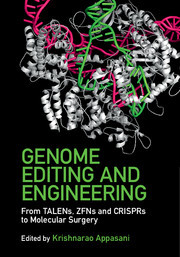Genome Editing and Engineering From TALENs, ZFNs and CRISPRs to Molecular Surgery
Langue : Anglais
Coordonnateur : Appasani Krishnarao
Préfacier : Church George M.

A complete guide to endonuclease-based genomic engineering, from basic science to application in disease biology and clinical treatment.
Recent advances in genome editing tools using endonucleases such as TALENs, ZFNs, and CRISPRs, combined with genomic engineering technologies, have opened up a wide range of opportunities from applications in the basic sciences and disease biology research, to the potential for clinical applications and the development of new diagnostic tools. This complete guide to endonuclease-based genomic engineering gives readers a thorough understanding of this rapidly expanding field. Chapters cover the discovery, basic science, and application of these techniques, focusing particularly on their potential relevance to the treatment of cancer, and cardiovascular and immunological disease. The final section discusses the legal and ethical issues which accompany the technology. Providing authoritative coverage of the potential that genome editing and engineering have, this is an ideal reference for researchers and graduate students and those working in the biotechnology and pharmaceutical industries, as well as in a clinical setting.
List of contributors; Forewords; Preface; List of abbreviations; Part I. Biology of Endonucleases (Zinc-Finger Nuclease, TALENs and CRISPRs) and Regulatory Networks: 1. Introduction to genome editing and engineering: from Talens, ZFNs and CRISPRs to molecular surgery; 2. Targeted genome editing techniques in C. elegans and other nematode species; 3. Unbiased detection of off-target cleavage by CRISPR-Cas9 and TALENs using integrase-defective lentiviral vectors; 4. In vivo studies of miRNA target interactions using site-specific genome engineering; 5. Don't kill the messenger: employing genome editing to study regulatory RNA interactions; Part II. Genome Editing in Model Organisms: 6. Genome editing in the crustacean Daphnia magna using CRISPR/Cas and TALEN systems; 7. Leapfrogging: a method for targeting genome editing to the germline; 8. Genome editing with desired mutations (knock-in) by CRISPR in model organisms; 9. Genetically engineered pig models for human diseases using ZFNs, TALENs and CRISPR-Cas9; 10. Gene editing to create agricultural and biomedical swine models; 11. Generation of new model cell lines using ssODN knock-in donors and FACS-based genome editing; Part III. Technology Development and Screening: 12. CRISPR genome editing in mice; 13. Detection of insertion/deletion (indel) events after genome targeting: pros and cons of the available methods; 14. Application of TAL proteins and the CRISPR system to purification of specific genomic regions for locus-specific identification of chromatin-associated molecules; 15. Application of CRISPR for pooled, vector-based functional genomic screening in mammalian cell lines; 16. Generation and utilization of CRISPR/Cas9 screening libraries in mammalian cells; Part IV. Genome Editing in Stem Cells and Regenerative Biology: 17. Targeted genome editing using nuclease assisted vector integration; 18. Genome engineering using Sleeping Beauty transposition in vertebrates; 19. Genome editing of pluripotent stem cells; 20. Principles for targeting adult tissue stem cells to achieve durable gene and gene-editing therapies; 21. Therapeutic genome editing in human hematopoietic stem and progenitor cells; Part V. Genome Editing in Disease Biology: 22. CRISPR/Cas9-Based in vivo models of cancer; 23. Inducible CRISPR-based genome editing for the characterization of cancer genes; 24. Genome editing for retinal diseases; 25. Manipulation of long non-coding RNAs in cardiovascular disease using genome-editing technology; 26. Gene silencing, disruption and latency reactivation with RNA-based and gene editing CRISPR/Cas, ZFN and TALEN technologies for HIV-1/AIDS therapies; 27. Use of the CRISPR-Cas9 system for genome editing of immune system cells, defense against HIV-1 and cancer therapies; 28. Harnessing therapeutic potential of long non-coding RNAs in immunity; Part VI. Legal (Intelluctual Property) and Bioethical Issues of Genome Editing: 29. Patening of CRISPR-based inventions; 30. Patent, ownership, and licensing issues of CRISPR-based genome editing: impact on universities and their licensees; 31. The ethics of human genome editing; 32. Regulating human genome editing: negotiating ethical concerns through science and policy; Index.
Krishnarao Appasani is the Founder and Chief Executive Officer of GeneExpression Systems. He is an award winning scientist, and has edited several books, including: Optogenetics: From neuronal function to mapping and disease biology (Cambridge, 2017); Genome-Wide Association Studies: From Polymorphism to Personalized Medicine (Cambridge, 2016); Epigenomics: From Chromatin Biology to Therapeutics (Cambridge, 2012); MicroRNAs: From Basic Science to Disease Biology (Cambridge, 2007); and RNA Interference: From Basic Science to Drug Development (Cambridge, 2005).
Date de parution : 08-2018
Ouvrage de 498 p.
17.7x25.2 cm
Disponible chez l'éditeur (délai d'approvisionnement : 14 jours).
Prix indicatif 183,14 €
Ajouter au panierThème de Genome Editing and Engineering :
© 2024 LAVOISIER S.A.S.



